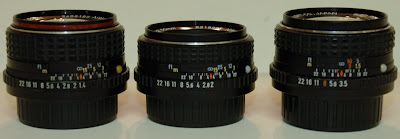Next, spare tires, your car has one, not so you can use it all the time, but so that you won't be stuck out there without a paddle, sorta speak. the good part of this spare situation is you CAN use the spare a bunch, which is part of the fun, making photographs. This lead me to my first thoughtful purchase, a wide-angle lens. Just like the Olympus 28mm, almost like the Olympus 28mm, ok, a 28mm. The thrifty part, do I buy the Canon brand for $130.00 or the small, cute Quantaray for $99.00?
Now, I'm running around with a Quantaray wide-angle, 28mm f/2.8 FD mount. She's a real little gem. I have never regretted getting this lens, and thirty years later, we are still clicking on and on.
"Ah", you say, looking at the picture, "what lovely do we have here?"
That, my photobuddies, is the Canon FTb, in black, my manual everything body, as I was into setting the camera.
This is Canon's scaled down version of their mighty F-1. Not smaller but with fewer features that I found I didn't need. Not that an F-1 wouldn't make a neat toy. This was my first used camera buy after I found out there was such a market. Boy am I slow. The lens is also used, but it is the second of this type, a Canon 50mm f/1.4 S.S.C. FD lens, the first one had the fatal oily aperture blade syndrome. I'll explain, there is a surplus of oil on the aperture mechanism, it leaks out on the blades and makes them close really slow, too much light hits the film, it goes eeeeee! and is over exposed. That is the characteristic of oily blades, an over exposed roll. I got a great deal on the replacement lens.
The FTb has an almost unique metering system. On the right of the display there is a ring that moves up and down depending on the aperture setting, and there is a floating needle that responds to the shutter speed and how much light there is coming in the lens. You turn the controls till the needle lines up with the circle and matches it. That is correct exposure, it is called match needle. On the FTb the width of the circle is one f/stop, putting the needle in the center of the circle is correct exposure, the top is 1/2 under exposed and the bottom is 1/2 over exposed. Simple.
The FTb also meters stopped down, you push the lever to the right of the QL label toward the lens and the lens stops down to shooting aperture AND the body converts to stopped down metering. This is with the modern FD lens mount and the older FL which requires it.The stopped down metering doesn't require any computing power to determine correct exposure, less to go wrong. My older Canon TL needs stopped down metering to correctly expose film and it is accurate. There are those who felt that closed aperture metering was more accurate but they are wrong, don't limit your journey with blocks, challenge the older ways with newer technologies, make photos faster.
Some of you might be a little bored with the stopped down metering, but it allows new paths especially those of us who like older equipment and there is a lot of inexpensive stuff floating around out there.
A quick note: the oily 50mm found a home on the TL as it requires stopped down metering and the lens is already stopped down when shooting.
The biggest advantage to stopping down: it forces you to look at the depth-of-field before you shoot.
Next: Depth-of-field











